Creating an outdoor classroom for homeschooling provides numerous benefits, including enhanced cognitive function, reduced stress, and improved physical health. To design an effective space, assess available areas and incorporate flexible seating, weather-resistant surfaces, and natural elements. Essential components include covered areas, storage solutions, and subject-specific zones for diverse learning experiences. Weather-proofing measures, such as proper drainage and wind protection, ensure year-round usability. Prioritize safety with appropriate fencing, clear pathways, and regular maintenance. By integrating sustainable materials and nature-inspired elements, you can create a dynamic learning environment that fosters ecological awareness and meaningful connections. The following sections offer in-depth guidance for maximizing your outdoor classroom's potential.
Benefits of Outdoor Learning
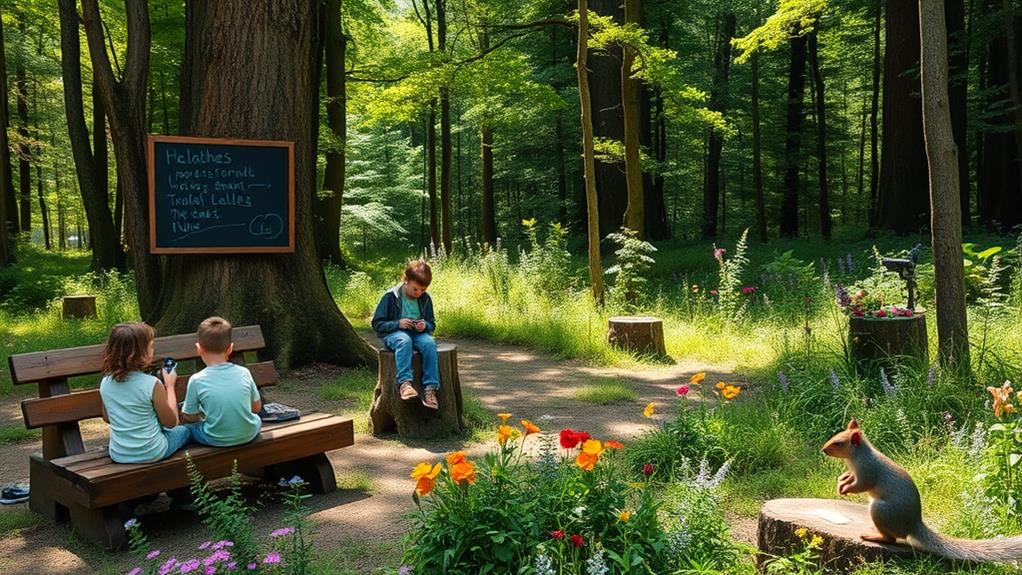
Through outdoor learning, children gain numerous cognitive, physical, and emotional benefits that are difficult to replicate in traditional classroom settings. Exposure to nature enhances cognitive function, improving attention span, memory, and problem-solving skills. The varied and dynamic outdoor environment stimulates curiosity and creativity, encouraging children to think critically and adapt to new situations.
Physically, outdoor learning promotes active lifestyles, reducing the risk of obesity and related health issues. It improves gross motor skills, balance, and coordination through activities like climbing, running, and exploring diverse terrains. Additionally, exposure to natural light and fresh air boosts vitamin D levels and overall immune function.
Emotionally, nature-based education reduces stress and anxiety while fostering a sense of wonder and connection to the environment. It builds self-confidence as children overcome challenges and develop independence. Outdoor learning also enhances social skills through collaborative activities and shared experiences.
Furthermore, environmental education cultivates ecological awareness and stewardship, preparing children to become responsible global citizens. By integrating academic subjects with real-world experiences, outdoor learning creates meaningful, lasting connections that enhance overall educational outcomes.
Designing Your Outdoor Classroom
Designing your outdoor classroom requires careful consideration of both functional and educational elements. Begin by assessing your available space and identifying areas that can be repurposed for learning. Consider incorporating a variety of seating options, such as benches, logs, or cushions, to accommodate different learning styles and activities.
Create designated zones for specific subjects or activities, like a science corner with observation stations or a quiet reading nook under a tree. Install weather-resistant whiteboards or chalkboards for demonstrations and group discussions. Incorporate storage solutions, such as weatherproof containers or a small shed, to keep learning materials organized and protected.
Integrate natural elements into your design, using rocks, plants, and water features as both learning tools and aesthetic enhancements. Ensure proper lighting for cloudy days or evening study sessions, and consider installing a shade structure for protection from sun and rain. Don't forget to include a comfortable workspace for the instructor, complete with necessary technology and resources. Finally, prioritize safety by implementing appropriate fencing, creating clear pathways, and removing potential hazards from the learning area.
Essential Outdoor Classroom Elements
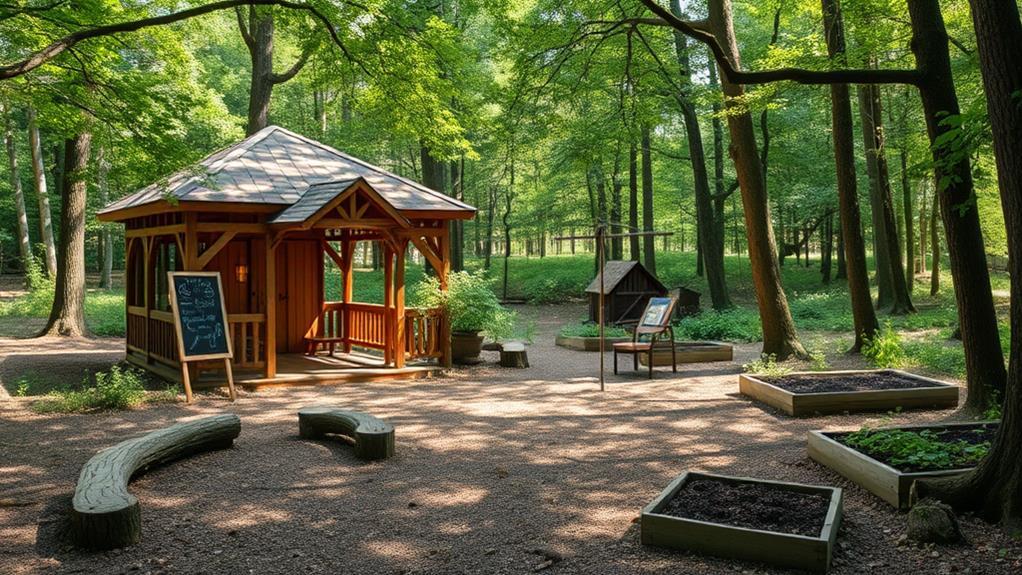
Building upon the design principles discussed, it's important to focus on the key components that make an outdoor classroom effective. These essential elements include flexible seating options, weather-resistant work surfaces, and adequate shelter from the elements. Incorporate a variety of seating choices, such as benches, stumps, and cushions, to accommodate different learning styles and activities. Install sturdy tables or create flat surfaces on existing structures for writing and hands-on projects.
A covered area, like a gazebo or pergola, provides protection from sun and light rain, allowing for extended outdoor learning sessions. Include storage solutions for educational materials and tools, such as weatherproof containers or a small shed. Integrate natural elements as learning aids, such as a garden for biology lessons or a weather station for meteorology studies. Ensure proper lighting for overcast days or early evening sessions, using solar-powered options when possible. Finally, consider installing a small sink or water source for easy cleanup and hydration. These core elements will create a functional and engaging outdoor classroom environment that supports diverse learning experiences in nature.
Weather-Proofing Your Space
Weather-proofing your outdoor classroom is crucial for ensuring year-round usability and protecting your investment. Start by installing a sturdy, waterproof roof or canopy to shield the area from rain and direct sunlight. Consider retractable options for flexibility in different weather conditions.
Install proper drainage systems to prevent water accumulation and potential damage to equipment or surfaces.
Choose weather-resistant materials for furniture and structures, such as treated wood, metal, or high-quality plastics. Apply protective coatings or sealants to extend their lifespan. Implement windbreaks using natural elements like hedges or artificial screens to reduce wind exposure. For colder climates, consider adding outdoor heating options like patio heaters or fire pits to extend usability into cooler months.
Ensure all electrical components are rated for outdoor use and properly protected from moisture. Install weatherproof storage solutions to keep supplies and equipment safe when not in use. Use UV-resistant fabrics for any soft furnishings or cushions. Finally, establish a regular maintenance routine to address wear and tear caused by weather exposure, keeping your outdoor classroom in optimal condition throughout the year.
Incorporating Natural Materials
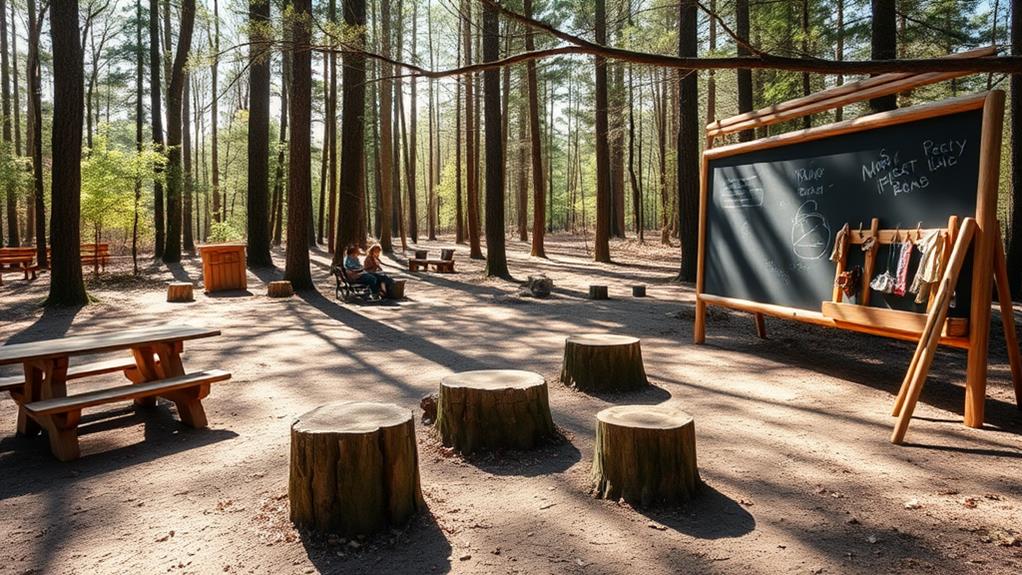
Natural materials play a crucial role in creating an authentic, immersive outdoor learning environment. When renovating your space for homeschooling in nature, prioritize the use of sustainable, locally-sourced materials that blend seamlessly with the surrounding landscape. Incorporate wood, stone, and bamboo into your design to create a harmonious atmosphere that encourages connection with the natural world.
Consider using reclaimed wood for seating areas, tables, and shelving units. Not only does this option reduce environmental impact, but it also adds character and warmth to your outdoor classroom. Integrate natural stone elements, such as pathways or retaining walls, to define spaces and provide texture.
Bamboo can be utilized for fencing, screens, or even as a sustainable building material for structures like pergolas or gazebos. When selecting materials, prioritize durability and weather resistance to ensure longevity in outdoor conditions. Choose non-toxic, eco-friendly finishes and treatments to protect both the environment and your students' health.
Creating Subject-Specific Learning Zones
Designing subject-specific learning zones within your outdoor homeschooling space enhances the educational experience and promotes focused learning. These dedicated areas allow students to immerse themselves in specific subjects while benefiting from the natural environment.
For science, create a garden or terrarium where children can observe plant growth, conduct experiments, and learn about ecosystems. Install a weather station for meteorology lessons and a sundial for astronomy studies.
Establish a mathematics zone with geometric shapes, measurement tools, and an abacus made from natural materials. For language arts, set up a cozy reading nook with weatherproof bookshelves and comfortable seating. Include a writing area with a sturdy table and supplies for creative expression.
Create an art corner with easels, nature-inspired art supplies, and a display area for finished works. For history and social studies, incorporate a world map mosaic and timeline pathway using stones or pavers.
Design a physical education area with balance beams, climbing structures, and open space for activities. Finally, include a quiet reflection zone for meditation and mindfulness practices.
Outdoor Classroom Safety Measures
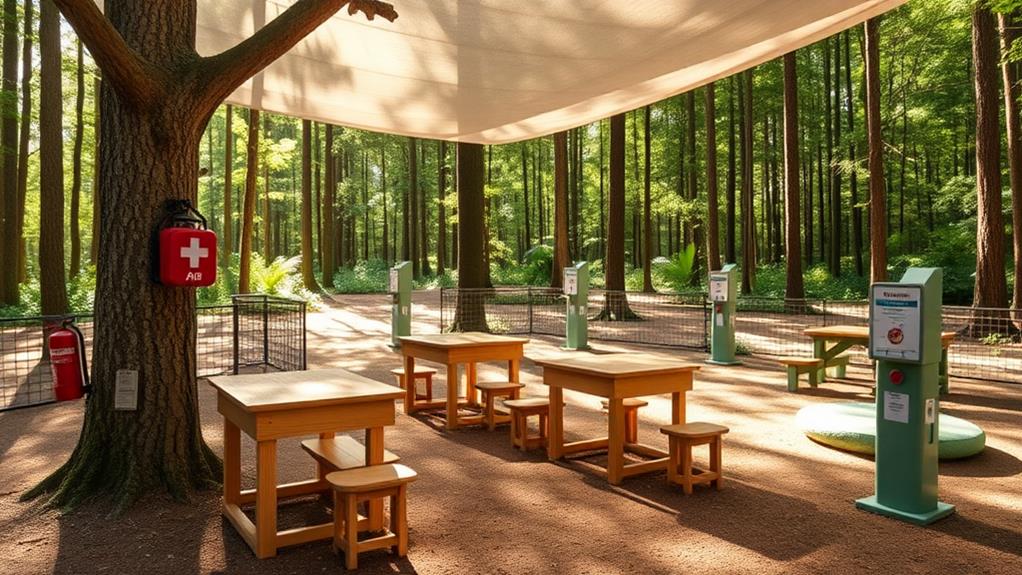
Prioritizing safety is paramount when creating an outdoor homeschooling environment. Begin by conducting a thorough assessment of the area, identifying potential hazards such as uneven terrain, poisonous plants, or bodies of water. Install appropriate fencing or barriers to define the learning space and prevent children from wandering into unsafe areas.
Ensure proper sun protection by creating shaded areas using canopies, pergolas, or strategically placed trees. Provide ample seating with weather-resistant materials and maintain a clean, debris-free space to prevent trips and falls. Implement a robust first-aid station, stocked with essential supplies and easily accessible in case of emergencies.
Consider weather-related safety measures, such as a lightning detection system and a designated indoor shelter for sudden storms. Establish clear safety protocols and emergency procedures, including regular drills. Incorporate proper lighting for early morning or evening sessions, and install secure storage for potentially hazardous materials like gardening tools or science equipment. Lastly, maintain open communication with local authorities to ensure compliance with any relevant safety regulations or permits required for outdoor learning spaces.
Seasonal Adaptations
Adapting an outdoor homeschooling space for different seasons ensures year-round learning opportunities and maximizes the use of the environment. To accommodate seasonal changes, consider implementing versatile structures and features that can be modified as needed.
For colder months, install retractable awnings or roll-down clear plastic sheets to create a sheltered area that still allows natural light. Incorporate portable heaters or a fire pit for warmth, and provide weatherproof seating with insulated cushions.
In warmer seasons, utilize shade sails or pergolas with climbing plants to create cool, shaded spaces. Install misting systems or outdoor fans for additional comfort.
Implement raised garden beds for year-round botany lessons, using cold frames or greenhouses to extend the growing season. Create a weather station with instruments to track seasonal changes and incorporate them into lessons. Use native plants in landscaping to attract local wildlife and observe seasonal patterns.
For wet weather, install proper drainage systems and create covered walkways. Invest in all-weather writing surfaces and storage solutions to protect materials from the elements. By adapting the outdoor classroom to seasonal changes, you can maintain an engaging learning environment throughout the year.
Technology Integration Outdoors
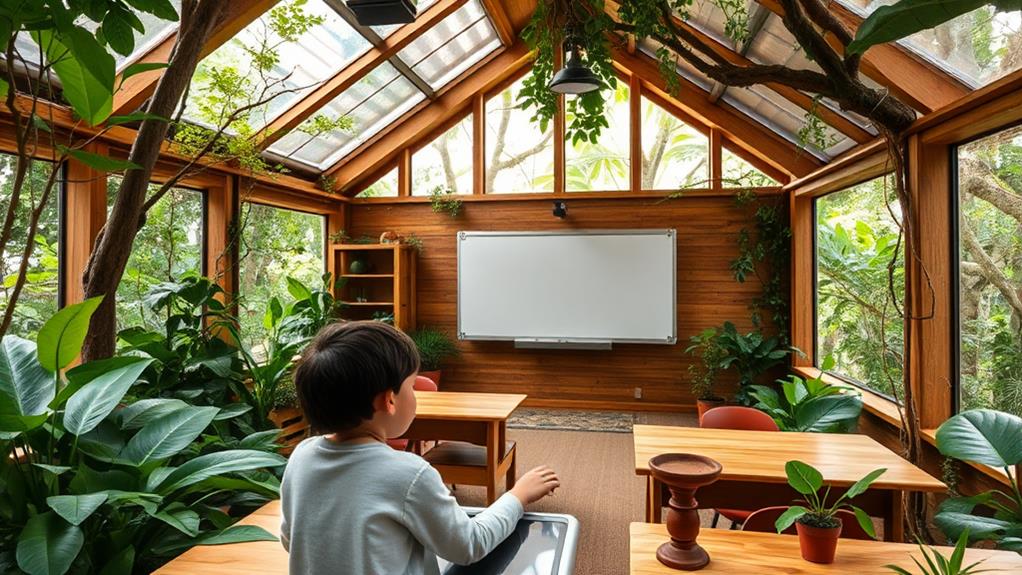
Integrating technology into outdoor homeschooling spaces requires careful planning and consideration of environmental factors. Weather-resistant devices and protective cases are essential for outdoor use. Solar-powered charging stations can provide a sustainable energy source for tablets, laptops, and other devices. Weatherproof electrical outlets and Wi-Fi extenders ensure consistent connectivity in designated outdoor learning areas.
Outdoor projectors and retractable screens can transform exterior walls or specially designed surfaces into interactive displays for group lessons. Portable digital microscopes and weather stations allow students to engage in hands-on scientific observations and data collection. Noise-canceling headphones can help minimize distractions from outdoor sounds during individual study time.
Consider creating a dedicated tech hub within a sheltered outdoor space, such as a covered patio or gazebo. This area can house more sensitive equipment and serve as a central charging station. Implement a robust outdoor storage system for technology, including lockable, waterproof containers to secure devices when not in use. By thoughtfully integrating technology, outdoor homeschooling spaces can offer the best of both worlds: natural immersion and digital learning opportunities.
Engaging the Community
Community involvement can significantly enhance the homeschooling experience in nature-based settings. By engaging local experts, organizations, and businesses, homeschooling families can expand their learning resources and create a more diverse educational environment. Local naturalists, for example, can offer guided nature walks, teaching children about native flora and fauna. Environmental organizations might provide workshops on conservation and sustainability, while nearby farms could offer hands-on agricultural experiences.
Collaborating with other homeschooling families or local schools can facilitate group activities and field trips, fostering social interactions and shared learning experiences. Community centers, libraries, and museums often offer educational programs that complement nature-based curricula.
Additionally, involving local artisans or craftspeople can introduce children to traditional skills like woodworking or weaving, connecting them to cultural heritage and sustainable practices.
Engaging the community also helps children develop a sense of place and civic responsibility. By participating in local conservation efforts or community gardens, students learn the importance of environmental stewardship and community service. This approach not only enriches the educational experience but also helps integrate homeschooling families into the broader community fabric.
Frequently Asked Questions
How Much Does It Cost to Set up an Outdoor Classroom?
The cost of setting up an outdoor classroom varies widely depending on factors such as size, materials, and features. Basic setups can start around $500, while more elaborate designs may cost $5,000 or more. Customization affects overall expenses significantly.
Are There Any Age Restrictions for Outdoor Learning Environments?
As clear as day, outdoor learning environments are suitable for all ages. While safety considerations may vary, there are no strict age restrictions. Educators and parents should tailor activities and spaces to suit the developmental needs of their specific age group.
Can Indoor Homeschooling Materials Be Used in Outdoor Classrooms?
Many indoor homeschooling materials can be adapted for outdoor use. However, consider weather-resistant alternatives for books and electronics. Laminated materials, waterproof containers, and digital devices with protective cases are suitable options for outdoor learning environments.
How Do You Manage Distractions in an Outdoor Learning Environment?
Managing distractions in outdoor learning environments requires clear boundaries, structured activities, and focused attention. Implement noise-reduction strategies, establish designated learning areas, and incorporate nature into lessons to maintain engagement and minimize external disruptions.
Are There Specific Certifications Required for Teaching in Outdoor Classrooms?
Specific certifications for outdoor classroom teaching vary by location and institution. Generally, standard teaching credentials apply, but additional training in outdoor education, environmental science, or wilderness first aid may be beneficial or required in some cases.
Conclusion
Outdoor classrooms offer a transformative approach to homeschooling, fostering enhanced learning outcomes and well-being. Research indicates that students in outdoor education programs score 27% higher on science tests compared to their indoor counterparts. By thoughtfully designing, equipping, and adapting these spaces, educators can create safe, engaging environments that seamlessly integrate technology and natural elements. As seasons change, outdoor classrooms evolve, providing year-round opportunities for experiential learning and community engagement. This innovative approach to education reconnects students with nature while meeting academic objectives.

